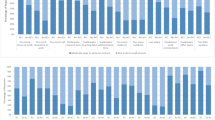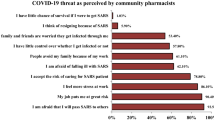Abstract
Objective To determine community pharmacists’ burnout levels and prevalences as well as factors associated with burnout. Setting Study was conducted in Ankara, the capital of Turkey. Method In this cross-sectional study, 251 pharmacists were randomly selected from 1,504 community pharmacists registered in Ankara Chamber of Pharmacists. A questionnaire including questions related to pharmacists’ individual and professional characteristics and Maslach Burnout Inventory was administered. The data was collected between February 27 and May 25, 2007. Main outcome measure Three Maslach Burnout Inventory subscales (emotional exhaustion-EE, depersonalization-D, and personal accomplishment-PA) scores. Results Pharmacists’ mean emotional exhaustion score was found to be 16.84 (SD: 6.25), depersonalization score was 4 (Range: 0–14), and personal accomplishment score was 22 (Range: 9–32). Of the pharmacists, 1.2% had high level of EE, .8% had high level of D, and 71.3% had high level of inefficacy. Age, marital status, work experience, work contentment, workload, time pressure, stress, and satisfaction with customers were found to be related with pharmacists’ burnout levels. Conclusion It can be useful to monitor pharmacists’ burnout levels and prevalences periodically. Interventions on individual and organizational basis were needed to cope with burnout, respond to job demands, minimize the level of chronic stress, and increase work contentment and satisfaction.
Similar content being viewed by others
References
Salanova M, Llorens S. Current state of research on burnout and future challenges. Pap Psicol. 2008;29(1):59–67.
Weber A, Jaekel-Reinhard A. Burnout syndrome: a disease of modern societies? Occup Med. 2000;50(7):512–7.
Maslach C, Schaufeli WB, Leiter MP. Job burnout. Annu Rev Psychol. 2001;52:397–422.
Maslach C. Job burnout: new directions in research and intervention. Curr Dir Psychol Sci. 2003;12(5):189–92.
Leone SS, Huibers MJH, Knottnerus JA, Kant IJ. Similarities, overlap and differences between burnout and prolonged fatigue in the working population. Q J Med. 2007;100(10):617–27.
Ahola K, Kivimäki M, Honkonen T, Virtanen M, Koskinen S, Vahtera J, Lonnqvist J. Occupational burnout and medically certified sickness absence: a population based study of Finnish employee. Psychosom Res. 2008;64(2):185–93.
Shanafelt TD, Balch CM, Bechamps GJ, Russell T, Dyrbye L, Satele D, Collicott P, Novotny P, Sloan J, Freischlag JA. Burnout and career satisfaction among American surgeons. Ann Surg. 2009;250(3):463–71.
Barnett CW, Hopkins WA, Jackson RA. Burnout experienced by recent pharmacy graduates of Mercer University. Am J Hosp Pharm. 1986;43:2780–4.
Lahoz MR, Mason HL. Burnout among pharmacists. Am Pharm. 1990;30(8):28–32.
Ergin C. Turkish health personnel norms for Maslach Burnout Inventory. 3P Journal (Dergisi). 1996; 4(1):28–33.
Daniel WW, Terrell JC. Business statistics. 7th ed. Boston: Houghton Mifflin; 1995. p. 871.
Salant P, Dillman DA. How to conduct your own survey. New York: John Wiley & Sons; 1994. p. 43.
Ergin C. Doktor ve hemsirelerde tukenmislik ve Maslach Tukenmislik Olceginin uyarlanmasi [Burnout among physicians and nurses and adaptation of Maslach Burnout Inventory] In: Bayraktar R, Dog I, editors. VII. Ulusal Psikoloji Kongresi Bilimsel Calismalari [VII. National Psychology Congress Proceedings]. Ankara:Turk Psikoloji Dernegi; 1993. p. 143–154.
Maslach C, Jackson SE. The measurement of experienced burnout. J Occup Behav. 1981;2:99–113.
Gupchup GV, Singhal PK, Dole EJ, Lively BT. Burnout in a sample of HMO pharmacists using the Maslach Burnout Inventory. J Manag Care Pharm. 1998; 495–503.
Beckstead JW. Confirmatory factor analysis of the Maslach Burnout Inventory among Florida nurses. Int J Nurs Stud. 2002;39(8):785–92.
Prins JT, Hoekstra-Weebers JEHM, Gazendam-Donofrio SM, Dillingh GS, Bakker AB, Huisman M, Jacobs B, van der Heijden FMMA. Burnout and engagement among resident doctors in the Netherlands: a national study. Med Educ. 2010;44:236–47.
Piko BF. Burnout, role conflict, job satisfaction and psychosocial health among Hungarian healthcare staff: a questionnaire survey. Int J Nurs Stud. 2006;43(3):311–8.
Tabolli S, Ianni A, Renzi C, Di Pietro C, Puddu P. Job satisfaction, burnout and stress amongst nursing staff: a survey in two hospitals in Rome. G Ital Med Lav Ergon. 2006;28(1 Suppl 1):49–52.
Wheeler H, Riding R. Occupational stress in general nurses and midwives. Br J Nurs. 1994;3(10):527–34.
Shamian J, Kerr MS, Laschinger HK, Thomson D. A hospital-level analysis of the work environment and workforce health indicators for registered nurses in Ontario’s acute-care hospitals. Can J Nurs Res. 2002;33(4):35–50.
Iglesias MEL, Vallejo RBB, Fuentes PS. The relationship between experiential avoidance and burnout syndrome in critical care nurses: a cross-sectional questionnaire survey. Int J Nurs Stud. 2010;47:30–7.
Rothmann S, Malan AM, Rothmann JC. Sense of coherence, coping and burnout in a corporate pharmacy group. 13–17 August 2001, 7th Annual PsySSA Conference, Johannesburg.
Ergin C. The meaning of work attitudes of health personnel in Turkey: a research manuscript. Ankara: Ministry of Health, Health Project General Coordination Unit; 1996.
Maslach C, Leiter MP. Early predictors of job burnout and engagement. J Appl Psychol. 2008;93(3):498–512.
Calgan, Z. Ankara Kent Merkezindeki Serbest Eczacilarin Tukenmislik Duzeyleri ve Etkileyen Faktorler (Community Pharmacists’ Burnout Levels and Related Factors in Ankara City Center) (Master Thesis) Ankara: Hacettepe University; 2007.
Karasek RA. Job demands, job decision latitude and mental strain: implications for job design. Adm Sci Q. 1979;24:285–308.
Linzer M, Visser MRM, Oort FJ, Smets EMA, McMurray JE, de Haes HCJM. Predicting and preventing physician burnout: results from the United States and the Netherlands. Amer J Med. 2001;111(2):170–5.
Elit L, Trim K, Mand-Bains IH, Sussman J, Grunfeld E. Job satisfaction, stress, and burnout among Canadian gynecologic oncologists. Gynecol Oncol. 2004;94(1):134–9.
Aslan D, Kiper N, Karaagaoglu E, Topal F, Guduk M, Cengiz OS. Turkiye’de Tabip Odalarina kayitli olan bir grup hekimde tukenmislik sendromu ve etkileyen faktorler. (Burnout syndrome and influencing factors in some of the physicians registered in Chambers of Physicians in Turkey). Ankara: Turk Tabipleri Birligi Yayinlari; 2005.
Ersoy F. Tukenmislik sendromu (Burnout syndrome). Surekli Tip Egitimi Dergisi. 2001;2:11–7.
Leiter MP, Maslach C. Six areas of work life: a model of the organizational context of burnout. J Health Hum Serv Adm. 1999;21(4):472–89.
Glebocka A, Lisowska E. Professional burnout and stress among Polish physicians explained by the Hobfoll resources theory. J Physiol Pharmacol. 2007;58(Suppl 5):243–52.
Karlidag R, Unal S, Yologlu S. Job satisfaction and burnout levels of physicians. Turk Psikiyatri Derg. 2000;11(1):49–57.
Bruce SP. Recognizing stress and avoiding burnout. Curr Pharm Teach Learn. 2009;1:57–64.
Gabbe SG, Melville J, Mandel L, Walker E. Burnout in chairs of obstetrics and gynecology: diagnosis, treatment and prevention. Am J Obstet Gynecol. 2002;186(4):601–12.
Acknowledgments
We are grateful to the Ankara Chamber of Pharmacists for providing pharmacists’ contact information and to all pharmacists who accepted to participate in the study. Also we would like to thank Prof. Dr. Albert I. Wertheimer at Temple University (Pennsylvania, USA) for revising our manuscript in terms of English wording and spelling.
Funding
This study was financially supported by The Scientific and Technological Research Council of Turkey within TUBITAK—BIDEB 2210.
Conflicts of interest
None declared.
Author information
Authors and Affiliations
Corresponding author
Rights and permissions
About this article
Cite this article
Calgan, Z., Aslan, D. & Yegenoglu, S. Community pharmacists’ burnout levels and related factors: an example from Turkey. Int J Clin Pharm 33, 92–100 (2011). https://doi.org/10.1007/s11096-010-9461-2
Received:
Accepted:
Published:
Issue Date:
DOI: https://doi.org/10.1007/s11096-010-9461-2




